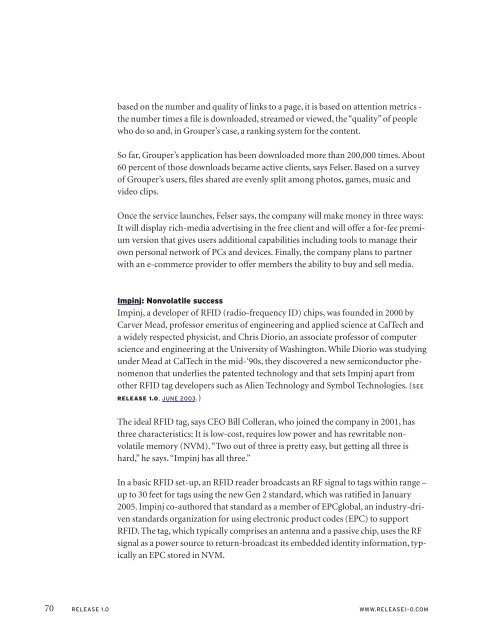The World Wide World: IT Ain't Just the Web ... - Cdn.oreilly.com
The World Wide World: IT Ain't Just the Web ... - Cdn.oreilly.com
The World Wide World: IT Ain't Just the Web ... - Cdn.oreilly.com
You also want an ePaper? Increase the reach of your titles
YUMPU automatically turns print PDFs into web optimized ePapers that Google loves.
ased on <strong>the</strong> number and quality of links to a page, it is based on attention metrics -<br />
<strong>the</strong> number times a file is downloaded, streamed or viewed, <strong>the</strong> “quality” of people<br />
who do so and, in Grouper’s case, a ranking system for <strong>the</strong> content.<br />
So far, Grouper’s application has been downloaded more than 200,000 times. About<br />
60 percent of those downloads became active clients, says Felser. Based on a survey<br />
of Grouper’s users, files shared are evenly split among photos, games, music and<br />
video clips.<br />
Once <strong>the</strong> service launches, Felser says, <strong>the</strong> <strong>com</strong>pany will make money in three ways:<br />
It will display rich-media advertising in <strong>the</strong> free client and will offer a for-fee premium<br />
version that gives users additional capabilities including tools to manage <strong>the</strong>ir<br />
own personal network of PCs and devices. Finally, <strong>the</strong> <strong>com</strong>pany plans to partner<br />
with an e-<strong>com</strong>merce provider to offer members <strong>the</strong> ability to buy and sell media.<br />
Impinj: Nonvolatile success<br />
Impinj, a developer of RFID (radio-frequency ID) chips, was founded in 2000 by<br />
Carver Mead, professor emeritus of engineering and applied science at CalTech and<br />
a widely respected physicist, and Chris Diorio, an associate professor of <strong>com</strong>puter<br />
science and engineering at <strong>the</strong> University of Washington. While Diorio was studying<br />
under Mead at CalTech in <strong>the</strong> mid-‘90s, <strong>the</strong>y discovered a new semiconductor phenomenon<br />
that underlies <strong>the</strong> patented technology and that sets Impinj apart from<br />
o<strong>the</strong>r RFID tag developers such as Alien Technology and Symbol Technologies. (SEE<br />
RELEASE 1.0, JUNE 2003.)<br />
<strong>The</strong> ideal RFID tag, says CEO Bill Colleran, who joined <strong>the</strong> <strong>com</strong>pany in 2001, has<br />
three characteristics: It is low-cost, requires low power and has rewritable nonvolatile<br />
memory (NVM). “Two out of three is pretty easy, but getting all three is<br />
hard,” he says. “Impinj has all three.”<br />
In a basic RFID set-up, an RFID reader broadcasts an RF signal to tags within range –<br />
up to 30 feet for tags using <strong>the</strong> new Gen 2 standard, which was ratified in January<br />
2005. Impinj co-authored that standard as a member of EPCglobal, an industry-driven<br />
standards organization for using electronic product codes (EPC) to support<br />
RFID. <strong>The</strong> tag, which typically <strong>com</strong>prises an antenna and a passive chip, uses <strong>the</strong> RF<br />
signal as a power source to return-broadcast its embedded identity information, typically<br />
an EPC stored in NVM.<br />
70 RELEASE 1.0 WWW.RELEASE1-0.COM
















